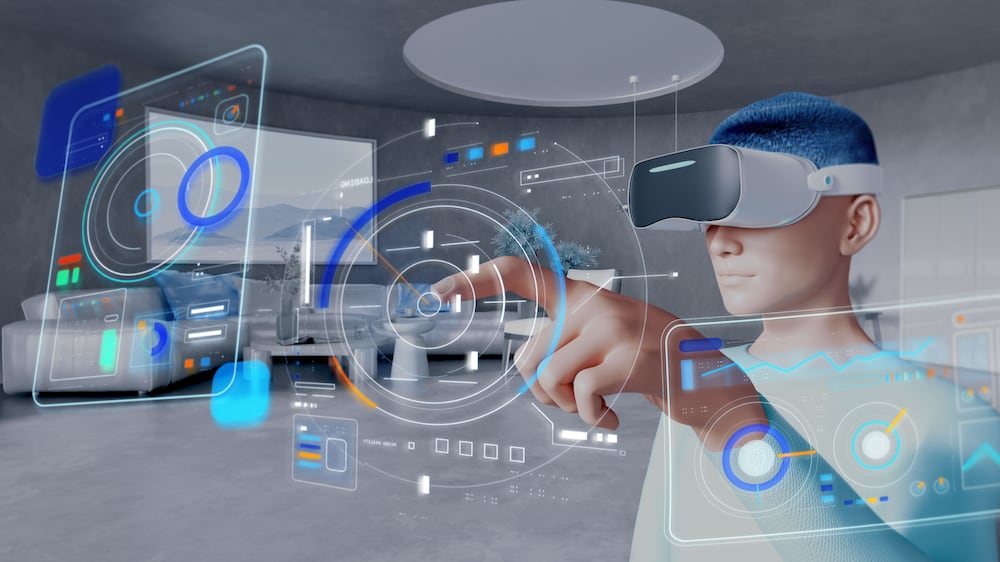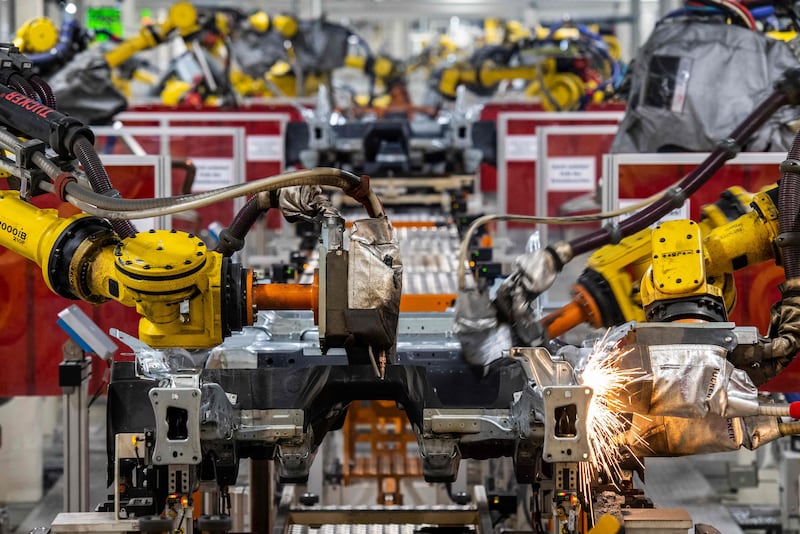Artificial intelligence will be the common theme in the top 10 technology trends in the next few years, and these are expected to quicken breakthroughs across key economic sectors and society, the Alibaba Damo Academy says.
The global research arm of Chinese technology major Alibaba Group says innovation will be extended from the physical world to a mixed reality, as more innovation finds its way to industrial applications and digital technology drives a green and sustainable future.
"Digital technologies are growing faster than ever," Jeff Zhang, president of Alibaba Cloud Intelligence and head of Alibaba Damo, said in a report released on Monday.
"The advancements in digitisation, 'internetisation' and intelligence are redefining a digital world that is characterised by the prevalence of mixed reality.
"Digital technology plays an important role in powering a green and sustainable future, whether it is applied in industries such as green data centres and energy-efficient manufacturing, or in day-to-day activities like paperless office."
The report was compiled after analysing millions of public papers and patent filings over the past three years and conducting interviews with about 100 scientists.
Cloud-network-device convergence

The rapid development of new network technology will fuel the evolution of cloud computing towards a new system called cloud-network-device convergence.
The system will allow clouds, networks and devices to have a more clearly defined division of labour.
Clouds will function as “brains” and will be responsible for centralised computing and global data processing, while networks will serve as the interconnecting “tracks” that join various forms of networks on the cloud to build an ubiquitous, low-latency network.
The global cloud computing market is projected to grow to $947.3 billion by 2026, from $445.3bn in 2021, according to data platform Markets and Markets, with adoption set to increase in sectors where initiatives to work from home are prevalent.
AI for science

AI would be a boon to scientists, with Alibaba Damo saying it will replace computers as the main production tool in scientific discovery, helping to improve efficiency in each phase of the research process – from the formation of initial hypothesis to experimental procedures and the distillation of experimental findings.
This will shorten research cycles and improve the productivity of scientists.
Machine learning can process massive amounts of multidimensional and multimodal data and solve complex scientific problems, allowing scientific exploration to flourish in areas previously thought impossible, it said. As such, AI will also help to discover new scientific laws.
The global scientific research and development services sector is, unsurprisingly, a big market. The sector is forecast to grow to $822.49bn this year and $1.3 trillion by 2026, from $725.56bn in 2021, data provider ReportLinker says.
Silicon photonic chips

As defined by Intel, a silicon photonic chip is the combination of two of the most important inventions of the 20th century – the silicon integrated circuit and the semiconductor laser. Unlike its electronic counterparts, it enables faster data transfers over longer distances.
The rise of cloud computing and AI will drive the rapid development of silicon photonics technology and demand. The widespread use of the chips is expected in the next three years.
Research company Markets and Markets predicts that the market will grow to $4.6bn by 2027, from $1.1bn in 2021.
The current challenges, according to Alibaba Damo, are mainly in the supply chain and manufacturing processes since the design, mass production and packaging of silicon photonic chips have not been standardised and scaled up, leading to low production capacity, low yields and high costs.
AI for renewable energy

Renewable energy is one of the sectors attracting the most attention as governments prioritise sustainability. But due to the unpredictable nature of renewable energy power generation, integrating renewable energy sources into the power grid presents challenges that affect the safety and reliability of the grid.
Alibaba Damo said the application of AI in the industry is critical and indispensable in capacity prediction, the scheduling of optimisation, performance evaluations, failure detection and risk management, all of which translates into improving the efficiency and automation of electric power systems and maximising resource use and stability. It would also be a key factor for achieving carbon neutrality.
A recent report by Allied Market Research said the global renewable energy market, which was worth $881.7bn in 2020, is expected to reach about $2tn by 2030.
Major economies have programmes in place to make renewables a significant part of their energy mix by that year: the US and China are on track to generate up to 50 per cent and 40 per cent, respectively, of their electricity from renewables.
High-precision medicine

As the Covid-19 pandemic has proved, any unexpected medical crisis will force the industry to hasten its research to achieve pinpoint accuracy.
With the medical field highly dependent on individual expertise involving a lot of trial and error, coupled with varying efficacies from patient to patient, the convergence of AI and precision medicine is expected to boost the integration of expertise and new auxiliary diagnostic technology.
It will serve as a "high-precision compass" for clinical medicine – a compass that doctors can use to diagnose diseases and make medical decisions as quickly and accurately as possible.
The medical world is already reaping the advantages of AI. For example, using AI in the early screening of breast cancers can reduce the false negative rate by 5.7 per cent in the US and 1.2 per cent in the UK, Alibaba Damo said, citing country statistics.
The global precision medicine market is poised to grow to $118.32bn by 2025, from $72.58bn in 2021, driven by companies resuming their operations and adapting to the new normal while recovering from the effects of Covid-19, according to ReportLinker.
Privacy-preserving computation

Privacy-preserving computation, as its name implies, is the use of techniques to process data – in utility bills, for example – without revealing a user's information. In an era where one of the largest challenges is ensuring the security of data while allowing it to flow freely between computing entities, this vertical is gaining traction as a viable solution to this challenge.
Alibaba Damo said that the next three years will see groundbreaking improvements in the performance and interpretability of privacy-preserving computation, and witness the emergence of data trust entities that provide data sharing services based on the technology.
Research company Gartner says that by 2025, half of large organisations will introduce privacy-enhancing computation for processing data in untrusted environments, while professional services company Accenture said its techniques will be critical to effective, safe and secure data sharing.
However, the application of the technology has been limited to a narrow scope of small-scale computation due to performance bottlenecks, lack of confidence in the technology and standardisation issues, Alibaba Damo said.
Extended reality

The development of technologies such as cloud-edge computing, network communications and digital twins brings extended reality – the combination of real and virtual worlds and human-machine interaction – into "full bloom", Alibaba Damo said.
XR glasses aims to further develop immersive mixed reality Internet. It will reshape digital applications and revolutionise the way people interact with technology in any scenario from entertainment and social networking, to office and shopping, to education and healthcare.
The XR market was valued at $27bn in 2018 and is expected to hit $393bn by 2025 at a healthy compound annual growth rate of 69.4 per cent, according to data provider Market Research Future.
Alibaba predicts that a new generation of XR glasses that have an indistinguishable look and feel from ordinary glasses will enter the market in the next three years and will serve as a key entry point to the next generation of the Internet.
Perceptive soft robotics

Perceptive soft robots are flexible, programmable and deformable, and are empowered by advanced technologies such as flexible electronics and pressure adaptive materials. This enables them to handle complex tasks in various environments.
AI further enhances their perception system, making them smarter and applicable to more industry functions such as for surgeries in the medical field.
Unlike conventional robots, perceptive soft robots are machines with physically flexible bodies and enhanced perceptibility towards pressure, vision and sound, allowing them to perform highly specialised and complex tasks and the ability to adapt to different physical environments.
The soft robotics market, still in its early stages, was valued at $1.05bn in 2020 and is expected to reach $6.37bn by 2026 at a CAGR of 35.17 per cent, according to Mordor Intelligence.
Alibaba Damo said the emergence of perceptive soft robotics will change the course of the manufacturing industry, from the mass-production of standardised products towards specialised, small-batch products.
In the next five years, it will replace conventional robots in the manufacturing industry and pave the way for wider adoption of service robots in daily life.
Satellite-terrestrial integrated computing

Current terrestrial networks and computing capabilities cannot catch up to the growing requirements for connectivity and digital services around the world, and is especially prominent in sparsely-inhabited areas such as deserts, seas and space.
Satellite-terrestrial integrated computing, Alibaba Damo says, creates a system that integrates satellites, satellite networks, terrestrial communications systems and cloud computing technologies, enabling digital services to be more accessible and inclusive across Earth.
The global satellite communication market was valued at $65.68bn in 2020 and is expected to hit $131.68bn by 2028, according to data provider Verified Market Research.
In the next three years, Alibaba Damo expects to see a large increase in the number of low-Earth orbit satellites, and the establishment of satellite networks with high-Earth orbit satellites.
In the next five years, satellites and terrestrial networks will work as computing nodes to constitute an integrated network system, providing ubiquitous connectivity.
Co-evolution of large and small-scale AI models

Future AI is shifting from the race on the scalability of foundation models to the co-evolution of large and small-scale models via clouds, edges and devices, which is more useful in practice.
In the co-evolution paradigm, foundation models deliver the general abilities to small-scale models that play the role of learning, inference and execution in downstream applications, Alibaba Damo said.
Small-scale models will also send the feedback of the environment to the foundation models for further co-evolution. This mechanism mutually enhances both large and small-scale models via positive cycles.
The would-be new "intelligent system" brings three merits: it makes it easier for small-scale models to learn the general knowledge and inductive abilities, which are then fine-tuned to their specific application scenarios; the system increases the variety of data for the foundation models; and it helps achieve the best combination between energy efficiency and training speed.
The global AI market was valued at $62.35bn in 2020 and is seen to expand at a robust CAGR of 40.2 per cent from 2021 to 2028, according to Grand View Research.
Continuous research and innovation directed by technology giants are driving the adoption of advanced technologies in industry verticals, such as automotive, health care, retail, finance and manufacturing, but AI has brought technology to the centre of organisations, it said.
Alibaba Damo Academy's forecast of the top 10 technology trends in the next few years








